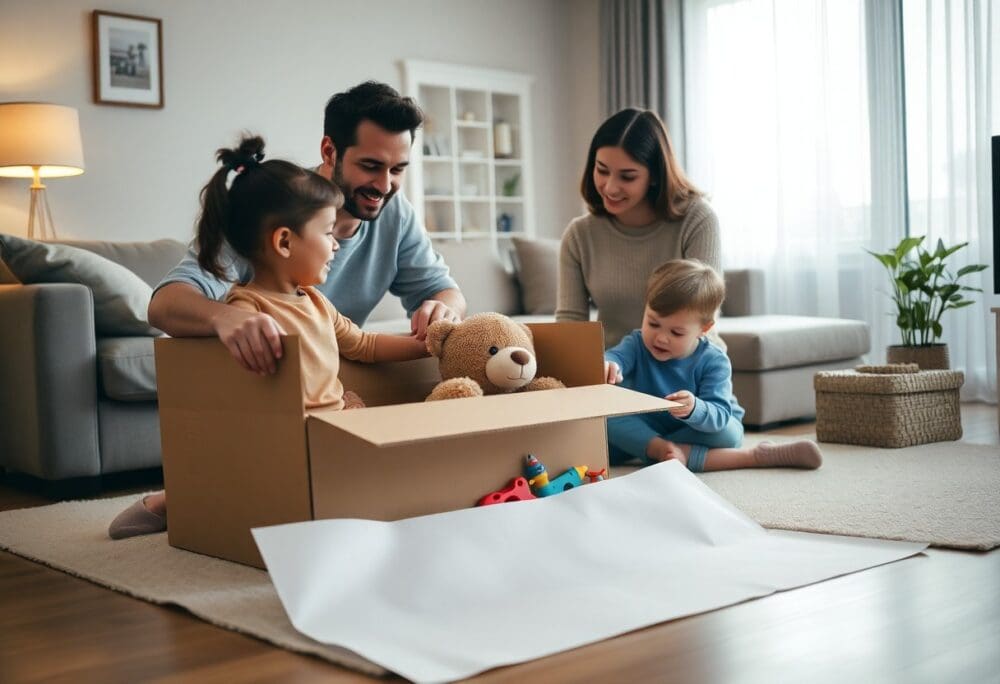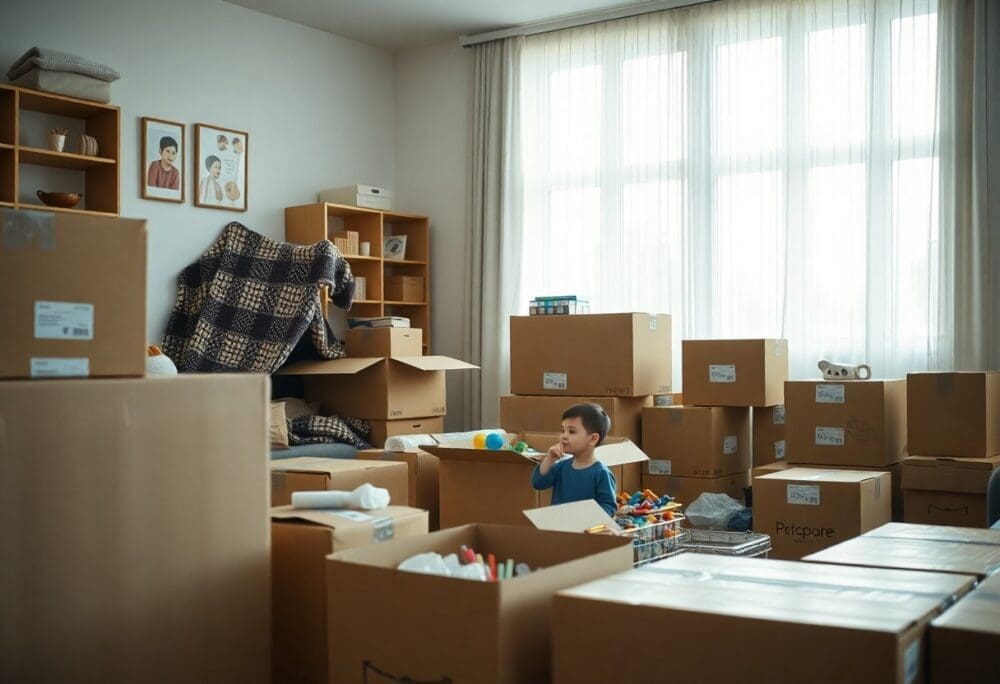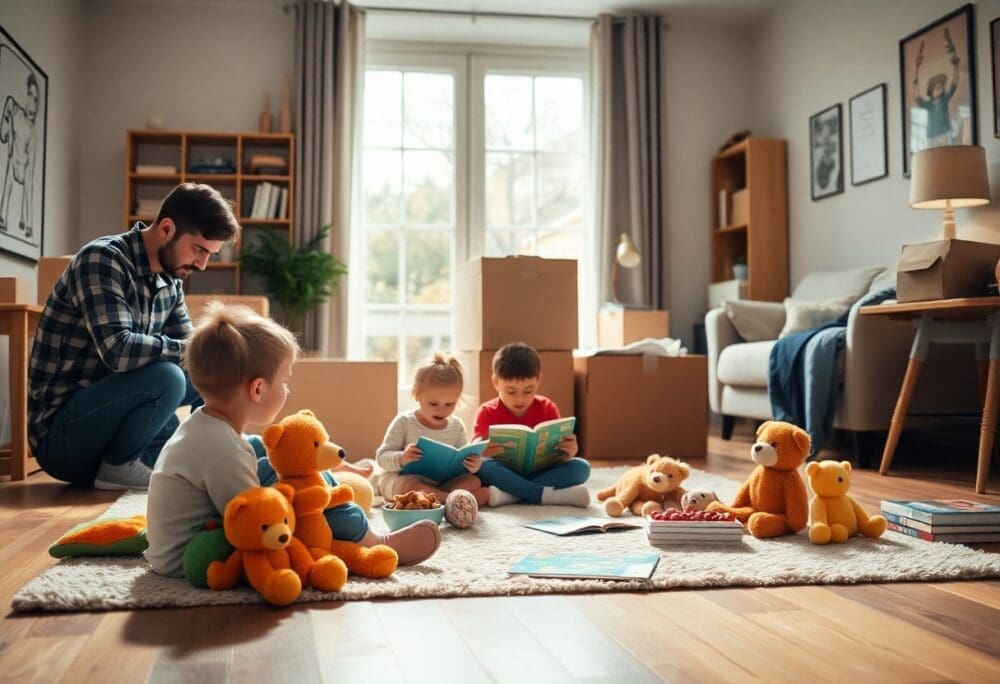It’s necessary to keep kids comfortable and calm during a family move to reduce stress for everyone involved. You can achieve this by planning ahead, involving your children in the process, and providing familiar items to ease the transition. Create a designated space for their belongings in the new home and ensure they have opportunities for play and relaxation amidst the chaos. With the right approach, you can help your children adjust more smoothly, making the moving experience less daunting and more positive for your family.
Key Takeaways:
- Communicate openly with kids about the moving process to alleviate anxiety.
- Incorporate familiar items and routines to create a sense of stability during the transition.
- Engage children in the moving process through age-appropriate tasks to foster a sense of involvement and ownership.
Understanding Children’s Emotions During Moves
Moving can trigger a complex mix of emotions in children, ranging from excitement to fear. As you navigate this transition, it is vital to understand that their feelings are valid and often stem from uncertainty about leaving familiar environments and friends behind. Helping them articulate these emotions can pave the way for a smoother adjustment.
Common Emotional Responses
Children may experience a variety of emotional responses during a move, including anxiety, sadness, or anger. Some may show resistance or withdrawal, while others might express excitement over the new possibilities. Each child reacts differently based on their personality, age, and awareness of the situation, making it necessary to pay close attention to their cues.
Importance of Acknowledging Feelings
Acknowledging your child’s feelings is a powerful way to help them cope with the stress of moving. When you validate their emotions, they feel heard and understood, which can significantly lessen their anxiety during this period of change.
Validating feelings allows your child to express their concerns openly, fostering a sense of security and support. For instance, if your child is upset about leaving friends, acknowledge their feelings by saying, “It’s okay to feel sad about leaving your friends. It’s a big change.” Share your feelings, too; this demonstrates that it’s natural to have mixed emotions. This two-way communication can encourage resilience and open the door to discussions about the exciting aspects of the move, such as new adventures and opportunities in a different place.
Preparing for a Move
Preparation plays a vital role in easing kids into the transition of moving. Start by communicating openly about the move, addressing their concerns and curiosity. You can provide them with age-appropriate information and resources to understand the experience better. Check out “We’re Moving?!” 7 Tips to Help Kids Thrive During A Move for practical advice that can help guide your discussions.
Involving Kids in the Process
Engaging your children in the moving process can significantly reduce their anxiety. Allow them to participate in packing their belongings or making decisions about what to take. This involvement fosters a sense of control, reducing feelings of helplessness during the transition.
Creating a Moving Plan Together
Creating a moving plan as a family not only organizes the process but also makes your kids feel included. Sit down with your children and outline a timeline for the move, discussing key dates and tasks. Assign them roles, such as labeling boxes or sorting through toys, which can make the move feel like a fun project rather than a daunting task.
By working together to develop this plan, you demonstrate to your children that the moving process is a collaborative effort. You may consider setting up a visual countdown calendar that highlights important dates, making the transition feel more tangible. Encouraging your kids to express their feelings about each stage can also foster open communication, enhancing their ability to cope with the changes ahead.
Packing Strategies
Effective packing strategies can make the moving process smoother for your kids. Start by involving them in the organization. Create a timeline that breaks down the packing process, ensuring you pace it to avoid overwhelming them. Use large, clear containers for items and label everything clearly. Emphasize the importance of imperatives versus non-imperatives, encouraging kids to prioritize what they truly want to keep close for the move.
Making Packing Fun
Turn packing into an enjoyable activity by incorporating games and challenges. Set a timer and see who can pack a box the fastest or have them decorate their boxes with stickers while discussing their favorite memories related to the items being packed. By transforming the experience into a light-hearted event, you can boost their morale and reduce potential stress.
Personalizing Boxes for Kids
Encouraging kids to personalize their moving boxes can foster a sense of ownership and excitement about the move. Each child can choose their favorite colors, themes, or characters to decorate their boxes, making their belongings feel more familiar. This act not only helps with identification but also adds a touch of creativity that can ease any anxiety about leaving their old home.
To personalize boxes effectively, provide a variety of decorating supplies like markers, stickers, and washi tape. You might also consider assigning a theme to each child’s collection, allowing them to use their favorite colors or characters. For example, if a child loves dinosaurs, they can create a box that features dinosaur stickers and drawings. This tangible connection to their interests will make unpacking in the new home more appealing, as they will have a visual reminder of their personality and preferences in their surroundings.
Creating a Safe and Comfortable Environment
Establishing a safe and comfortable environment helps children feel secure during the moving process. To create this atmosphere, first assess the new space for any potential hazards, such as sharp corners or inaccessible areas. Make necessary adjustments or childproofing to ensure safety. You’ll also want to set a calming tone with low lighting and soothing colors in their room, creating an inviting retreat where they can unwind amidst the chaos.
Setting Up Their Space First
Prioritize setting up your child’s space before unpacking the rest of the house. Designate their room as the first area to organize, arranging furniture and unpacking vital items like bedding, toys, and personal decor. Allow them to help in the process, choosing where each item goes. This involvement provides a sense of control and investment in their new home, promoting feelings of stability and comfort.
Familiar Items that Help Calm
Incorporate familiar items that help your child feel calm during the move. These might include favorite toys, blankets, or family photos. Surrounding them with things they recognize contributes to a sense of belonging and makes the new space feel less foreign.
Utilizing familiar items can significantly enhance your child’s comfort levels. For instance, having their favorite stuffed animal or a comforting blanket readily available can provide instant solace. Items like family pictures or cherished toys invite a sense of continuity from the old home to the new one. Depending on your child’s preferences, even packing a small ‘comfort box’ with these vitals can serve as a soothing anchor during the upheaval of moving. Ensure these items are accessible right away to help ease any anxiety they may feel about their new surroundings.
Maintaining Routines
When moving, maintaining your child’s daily routine can significantly ease their anxiety. Keeping familiar patterns in place provides a sense of stability amidst change. Aim to uphold regular meal times, bedtimes, and daily activities. This not only supports their emotional well-being but also helps them adjust to their new environment more smoothly.
Keeping Daily Schedules
To keep daily schedules intact during the move, use a calendar or planner to mark out imperative activities. You can maintain consistency by following the same wake-up and sleep times, which aids in creating a predictable environment for your child. Stick to established routines as much as possible, even amidst the chaos of packing and unpacking.
Incorporating Familiar Activities
Incorporating familiar activities into your moving process helps provide a comforting touch for your kids. Whether it’s reading their favorite bedtime story or maintaining playtime routines, these consistent habits can significantly alleviate stress associated with the move.
Engage your child by encouraging them to participate in their favorite hobbies and activities throughout the transition. For instance, if they enjoy drawing, set aside time for them to create in their new space. Including time for familiar activities like family game nights or movie marathons brings a sense of normalcy. This approach engages their interest, reinforces existing routines, and fosters a positive mindset during the upheaval of moving. Emphasizing continuity with these small acts can create a reassuring atmosphere that helps them feel more at home in their new surroundings.
Communication and Reassurance
Establishing a connection through communication and reassurance is vital for your child’s emotional well-being during a move. Addressing concerns directly and providing answers can alleviate anxiety. For further insights, consult the Advice for Moving With Children to better understand how to navigate this transition with your kids.
Open Discussions About the Move
Having open discussions about the move allows your child to express their feelings and concerns. Discuss what the new home will be like, the reasons for moving, and the exciting opportunities that await. Validating their feelings encourages them to verbalize their worries, creating a sense of security.
Regular Check-Ins with Kids
Frequent check-ins with your kids about how they feel regarding the move nurture their emotional health. Schedule specific times to sit down and discuss their thoughts, providing a platform for them to share their experiences and emotions. This ongoing support builds trust and reassures them that it’s okay to feel a mix of excitement and anxiety.
As you engage in regular check-ins, use this time to gauge any behavioral changes in your kids. Open-ended questions can facilitate deeper conversations, allowing them to articulate feelings that may seem insignificant. You can ask about their expectations for the new neighborhood, new friends they might meet, or concerns about starting in a new school. By actively listening, you reinforce a safe space, making it easier for them to process the transition.
To wrap up
Presently, keeping kids comfortable and calm during a family move requires planning and patience. You can create a positive environment by involving your children in the moving process, establishing a familiar routine, and allowing them to pack a personal bag of crucial items. Providing reassurance and frequent check-ins can help ease their anxiety. Additionally, considering fun entertainment options for the journey will keep their spirits high. By implementing these strategies, you ensure a smoother transition that minimizes stress for your family.
FAQ
Q: How can I prepare my kids for the move ahead of time?
A: Involve your children in the moving process by discussing the upcoming changes. Share details about the new home and neighborhood, and let them help pack their belongings. Plan visits to the new area, if possible, to familiarize them with the surroundings.
Q: What activities can I plan to keep my kids occupied during the move?
A: Create a moving day kit with games, books, and puzzles to keep them entertained. Schedule activities such as a scavenger hunt at the new home or set up a comfortable space with their favorite toys and snacks during the transition.
Q: How can I help my kids handle their emotions about moving?
A: Encourage open conversations about their feelings regarding the move. Acknowledge their emotions and validate their concerns. Consider setting up playdates or social activities in the new area shortly after moving to help them build connections and feel more at ease.







